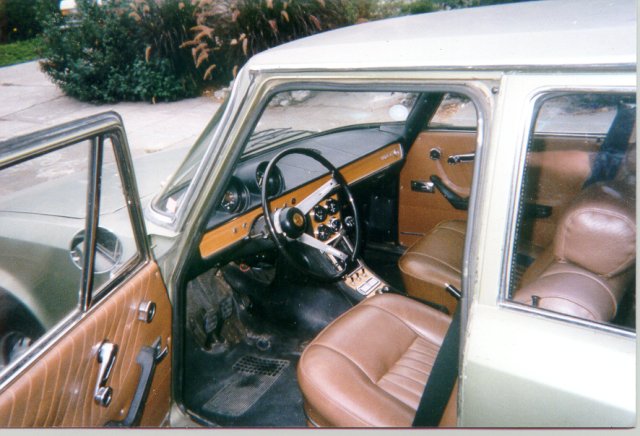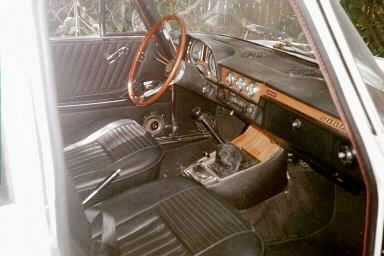



InteriorThe Berlina has reclining bucket front seats and a bench rear seat. The early front seats had no headrest, looking very much like Giulia Super seats. Beginning in 1969 with the introduction of US models, all later Berlinas had headrests in front. The rear seat is supposed to fit three people. Some or all 1750 cars came from the factory with an removable seat insert to go on the rear driveshaft hump and opening storage compartment/armrest that can be installed when only two people will be sitting in back. 2000 cars have a drop-down armrest/storage compartment in the center of the back seat. I have seen two different version of this armrest.
Early seat material is a very stretchy and sticky vinyl, with a pattern like pigskin; later seats have a stiffer type of vinyl. Supposedly leather was a factory option in some countries, though I have never seen it. Velour was an option for non-US cars, particularly on 2000s. Most Berlinas seem to have tan interiors, though black is probably the second most common color. The early tan is fairly dark; later tans are almost white.
Door panels are finished in the same material as the seats, and have a plastic-welded pattern. Door panels have an angled door pull, a door release handle, a pull-up lock, and a window crank. The front doors also have the vent window winder, and the rear doors each have a small ash tray. 2000 cars (at least in the US) have a small red safety reflector in the lower rear corner of each door.
Early carpets are multi-piece grey wool just like Giulias; early 2000s have a loop-weave nylon multi-piece carpet, usually in black. Visible edges of the multi-piece carpets are bound. Late 2000s, at least in the US, have one-piece molded nylon carpets. A rubber heel pad and tunnel pad is built into the carpeting on the driver's side. Stainless kick panels on the sills cover the carpet edges.
The 1750 dashboard is similar in style to the 1750 GTV dash. The dash is mainly black formed plastic, with a wood insert on the facing, surrounded by chrome trim. The two main instruments (speedometer and tachometer) have white numbers on black with black surrounds, and protrude noticeably in pods from the top of the rear-angled surface of the dash. The four other instruments (oil pressure, water temperature, fuel gauge, and clock) are located on the vertical part of the center console, angled towards the driver. Each has a chrome bezel. The top of the dash contains two defroster/heater outlets that can be turned. The glove box has a locking door that swings down. See a 1969 US 1750 Berlina interior below.

The center console drops vertically from the dash, slanting down to surround the shifter, and terminating in a storage bin, ashtray, and switches between the seats. The shifter in its vinyl boot, heater sliding controls, and cigarette lighter are also in the console. The console has the same wood facing as the dash. The sides of the console are black plastic. There are two speaker grills on the sides of the console.
The 2000 dash is entirely different. It is still black plastic, but the facing is different, and the main instruments, made by either Jaeger or Veglia, are now black letters on white, and contained in a single binnacle with wood facing. The oil pressure gauge is incorporated into the tachometer. The other instruments (fuel gauge, water temperature, and clock) are located in the center of the dash, angled toward the driver. They too are black on white. The center console is much more horizontal than on the 1750, and there is room there for an optional air conditioner. The top of the dash has two defroster outlets, and the face of the dash has two "eyeball" fresh air vents that draw air from the grill area in front of the windshield. If air conditioning is fitted to the car, the blower unit replaces part of the center console area in front of the shifter and beneath the dash. See a 1974 US 2000 Berlina interior below.

Charles Haff reports that the factory-installed radio in 1969 1750 Berlinas was a Blaupunkt three- band push-button radio. This must have been an option, as my 1969 1750 (original dash) has never had a radio or antenna installed in it. The 1974 2000 was supplied without a radio from the factory; presumably radios were a dealer-installed option. I would assume that all 1750s equipped with the radio came with the Blaupunkt, and that all 2000s came with no radio. However, I've seen this Blaupunkt three-band radio installed in three different 1974 US 2000 Berlinas, so it probably was a common dealer option. As mentioned above, the 1750 console has speaker grilles built in; I don't know about the 2000 console.
The emergency brake handle is a large chrome pull-up lever with a black plastic end and chrome release plunger between the seats on the driveshaft tunnel. The handle has a vinyl boot that fits into an opening in the carpet.
Berlina headliners all are white or off-white, in the standard Alfa "snakebite" pattern vinyl. On 1750s, the headliner material is stitched together, and has a thin vertical section just in front of the back window is dark grey or black, and contains larger perforations to allow air to flow out the extractor vents on the rear window pillars. 2000 Berlinas have "welded" plastic seams in the material, and the extractor section near the back window is the same color as the rest of the headliner. The sun visors are black vinyl or black back/white front and swing down and to the side; the passenger side visor has a small vanity mirror. The rearview mirror has a black metal mount with black plastic frame and a day/night feature. The mirror is head onto the body by a spring, so that it will break away in an accident. There is a small stainless steel switch panel at the top of each door pillar, with a small sliding switch that operates the interior lights. The light itself has a white plastic cover, over each rear door, in a cast metal piece in unit with the rear grab handle. The Berlina grab handles are a black and silver woven plastic, with a swing-down pivot.
Several different steering wheels were used. Early non-US cars used a three-spoke aluminum wheel with a black plastic rim and three black horn pushes much like late Giulia Super or GTV wheels. Later non-US cars used a wooden wheel like the US Spider and GTV wheel. 1750 US cars had a steel three-spoke wheel with thin black plastic rim, made by Helleboro. 2000 US cars had a slightly smaller diameter three-spoke steel wheel with a thicker plastic imitation-wood rim, probably also made by Helleboro. On all the steel wheels, there is a horn-push in each spoke.
The Berlina heater is common to other contemporary Alfas, with a small radiator under the dash, a two-speed fan, and sliding controls for the amount of hot water admitted, and for directing the heat to the windshield, the feet, or both. The heater draws air from the grill in front of the windshield.
All Berlinas came with seat belts in all four seats. 1750s and early 2000s have an adjustable three-point system with metal buckles in front and lap belts in back. 1974 US 2000 Berlinas have Klippan inertial-reel three-point shoulder harnesses in front and lap belts in back. Beginning with the 1973 model year, US Berlinas, like GTVs and Spiders, have a Bosch interlock ("sicherheitgurtlogik") installed under the passenger-side dash that prevents the car from being started if a front seat is occupied but the belt is not fastened. The box is connected to sensors under the front seats.
2000 Berlinas had optional air conditioning. If fitted, the compressor is on the exhaust side of the engine, hanging on a large bracket off two large studs in the front of the head. The evaporator fits between the dashboard and the console, with its own outlets. Most cars with air conditioning had the battery location moved to the trunk.

Copyright © 1997 by Andrew D. Watry
Questions or Comments? Email Me